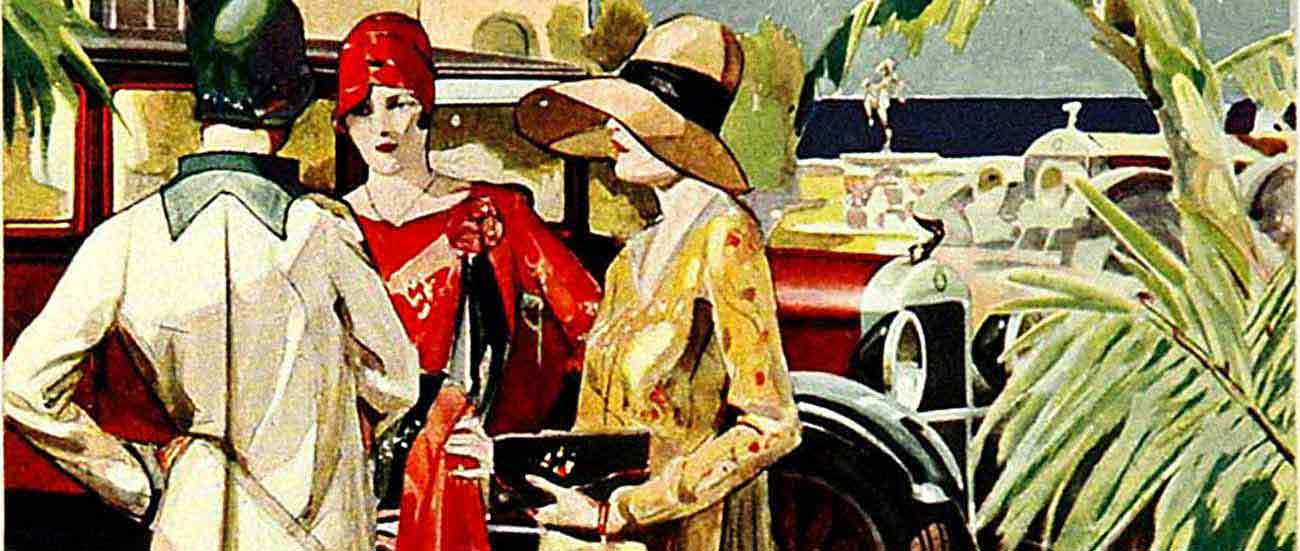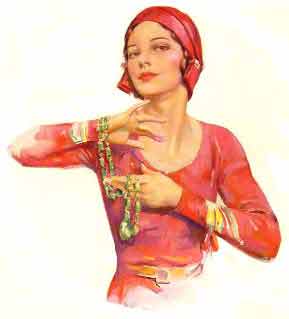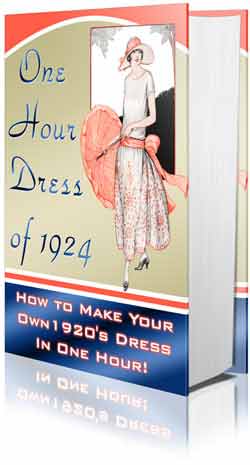Beautiful coordinated and accessorized outfits were a feature of 1920's ladies fashions. Hats, shoes, stockings, handbags, dresses and jewelry all came together in perfect harmony to create a unique and elegant style that can only be appreciated when seen in real-life or in color illustrations. The vibrancy is lost in black and white photographs that typically showcase the era.

1920's Womens Fashions and Changing Lifestyles
Womens fashions in the early 1920's experienced dramatic changes following the end of the first world war, in a period often referred to as the "roaring 20's", the era of the "flapper".
The passing of bustles and corsets gave clothing designers much greater freedom of expression resulting in innovative styling. Women dressing in the new and colorful fabrics echoed the joy felt by a war weary population following the end of hostilities.
The rate of change in clothing styles for women and children accelerated during the 1920's along with a decline in purchase costs. This increased the demand for dresses in particular, with silk and rayon hosiery not far behind.
1920's Dresses were lighter (due to less material and new synthetic fabrics) and brighter and shorter than ever before. Fashion designers played with fabric colors, textures and patterns to create totally new styles of dress. Evening dresses, coats and jackets were often trimmed with fur. Fur coats dropped in popularity while fur trimmed coats, especially for women, followed an upward trend. Hemlines rose for most of the decade but dropped slightly toward the end.
The popular trend toward silk and rayon reflected a taste for luxury in the 1920's and as a result cotton became less fashionable. Women's underwear which had been primarily cotton before 1920 was predominantly fashioned from silk and rayon by the end of the decade. Young women in particular discarded cotton underwear for the new materials while older women were slower to change. Likewise city people made the change to the new materials and styles far sooner than country people.
Shoes and stockings assumed a greater prominence now that they were more visible. Silk stockings in all the colors of the rainbow, often with patterns, were designed to match the coordinated outfits of stylish women.

"Ensembling" was part of the new fashion trends and so purses and handbags became fashion items in a co-ordinated fashion statement. At the same time there was a marked decrease in the use of hooks and eyes, and feathers and plumes. The use of perfumes, cosmetics and toilet preparations skyrocketed due to a massive advertising effort in periodicals, newspapers, and radio.
Correspondence schools flourished in the inter-war period as people sought to educate themselves and create a better future for themselves and their families. Dressmaking and millinery courses in particular were embraced by women who wanted the new fashions but couldn't afford retail prices. Others were looking to create full or part-time jobs for themselves.
Many women turned to fashion as a vocation in order to support their fatherless families in the case of war widows, or to earn extra income to spend on the new luxuries. Working women also embraced the relatively inexpensive ready-made clothes as mass production of contemporary clothing became common.
It didn't matter if there wasn't a department store in your town or city where you could shop for clothes or accessories as all the big department stores had mail-order catalogs where you could order clothes for men, women, and children for delivery by post. This meant country people had easy access to city fashions for the first time.
Pantsuits, hats and canes that gave women a sleek look without frills and avoiding the fickleness of fashion were popular for a while. The style was named after the novel La garçonne by Victor Margueritte. In Europe, this look featured women with short hair (Bubikopf) for the first time; in the U.S., "the bob" was reintroduced by actress Louise Brooks in the late 1920s.
The hairstyles of Hollywood stars were copied by women all over the world and womens magazines carried articles on how to achieve the current look. Hairstyles were much shorter than the previous decade and styles like finger waving, the Marcel wave and permanent waving were in vogue.

Women's underwear changed as a result of this move towards practical clothing, with corsets becoming smaller and more flexible, and modern style bras being introduced. The new bras provided shape and support whereas the older style tended to flatten breasts and constrict the chest.
Flappers, as the trendy young women were called in the U.S., wore short dresses with a straight loose silhouette. By 1927 seams had risen to just below the knee, so that part of the knee could be seen when dancing the Charleston.
Thus, the Roaring Twenties redefined womanhood — a new woman evolved; it became more acceptable to smoke and drink in public, closer body contact in dancing, shorter hair, make-up, different styles of dress, and greater participation in the workforce - all contributed to the new woman.
1920S FASHION RESOURCES
The One Hour Dress
Instructions for making a flapper dress based on a genuine 1920's dress pattern.
Fingerwave Hairstyles
Lessons on how to create fingerwave hairstyles based on 1920's movie star hairstyles.
Cutting and Styling Hair
A 1920's hairdresser teaches cutting and styling techniques for Bobbed hair.
Retro Makeup: Techniques for Applying the Vintage Look
Makeup instructions for creating the 1920's look.
1920's Haircare and Hairstyles
Pictures of 1927 Ladies Hairstyles and haircare information from Actress Ann Harding.
Home Millinery Lessons
Simple instructions on the basics of making a hat of the period.
1920 Fall-Winter Fashions
1920 Dress information as published by the Woman's Institute Fashion Service magazine, Fall and Winter edition 1920-1921 to help women
plan and develop their own clothes for the approaching Winter.
Female Motoring Fashion Advice - 1917
Fashion tips for Women driving in Automobiles

